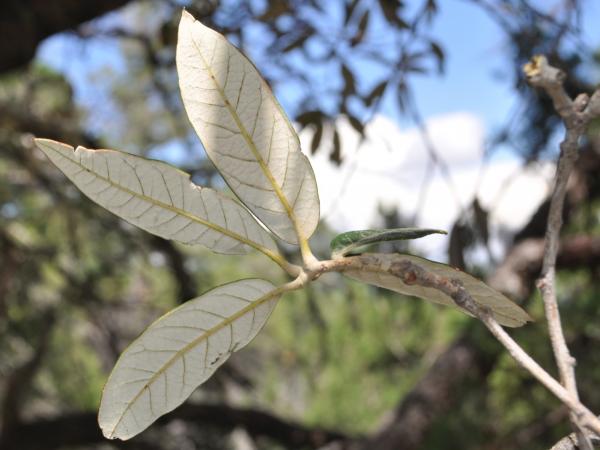Editor's Picks
Plant Focus
Red List of US Oaks Published by The Morton Arboretum
One-fourth of the United States’ oak species are now considered of conservation concern, according to data compiled by researchers at The Morton Arboretum for the latest update of the International Union for Conservation of Nature (IUCN) Red List of Threatened Species™. Sixteen species of oaks, all in the southern and western U.S., are now classified as Critically Endangered, Endangered, or Vulnerable on the IUCN Red List, with another four species deemed Near Threatened. This proportion of threatened species within a taxonomic group is similar to threat levels for birds and mammals.
Released this September, The Red List of US Oaks details for the first time the distributions, population trends, and threats facing all 91 native oak species in the U.S., including updated versions of previously published assessments. The publication serves as a baseline for current understanding of the state of the country’s oak trees and an authoritative guide for future conservation action.

This report marks the first complete evaluation of all native U.S. oak species, including 24 species that had never previously been assessed. Of the 91 native U.S. oak species, 20 are of conservation concern, including 16 that reach the threshold for one of the threatened categories of Vulnerable, Endangered, or Critically Endangered and 4 that fall into the Near Threatened category. NT species almost reach the threshold that would categorize them as threatened or have imminent threats that could cause them to become threatened very quickly. The majority of Quercus taxa in the U.S. are assessed as Least Concern. These species often have large distributions and are not at a high risk of extinction.
Generally species richness of oaks increases from north to south in the United States, with Texas having 48 native species, the highest number of any state. California contains the highest number of oak species of conservation concern (nine species), followed by Texas and Alabama, both with five oak species of concern. Southern California represents a threatened oak diversity hotspot and is of critical importance for focusing conservation efforts.

Some of the major threats to oak species in the U.S. include both native and non-native pests and diseases, problems caused by changing climate such as drought, changes to landscape through fire and fire suppression, residential and commercial development, and land use change due to agriculture. Notably, longevity and slow reproductive rates of oaks make them particularly susceptible to the effects of a rapidly changing climate.
“In addition to being iconic and beloved tree species in many parts of the world, oaks support many important ecosystems, such as oak savannas in the American Midwest and cloud forests in Mexico and Central America. Countless animals and other plants depend on oak-dominated habitats for survival. So, as oaks disappear, there will be a tangible, negative impact on wildlife, potentially upsetting the balance of forest habitats,” said project lead Murphy Westwood, director of global tree conservation at The Morton Arboretum. “With the IUCN Red List assessments and associated report, we now have a baseline from which to determine how to best conserve oaks and reverse the trend toward extinction for these important trees.”
Adding to oaks’ struggle, acorns cannot be stored in seed banks through conventional preservation methods like most tree species, so growing them in living collections in arboreta and botanical gardens is imperative for long-term survival of the species. In partnership with the American Public Gardens Association and the U.S. Forest Service, The Morton Arboretum has a key role in a coordinated network of organizations growing and conserving threatened oaks, such as the Endangered shinnery oak (Quercus havardii), propagating thousands of acorns and cuttings, and distributing plants across the network. As the climate changes—models suggest the climate of Illinois will eventually be similar to that of today’s Arkansas or even Texas—the Arboretum and other public gardens may become critical refuges for even more oaks.

An ongoing effort
In 2015, The Morton Arboretum established a partnership with the IUCN Global Tree Specialist Group and Botanic Gardens Conservation International to assess all 450 of the world’s oak species by 2020, contributing to a global initiative to evaluate the threat level of the 60,065 species of trees in the world - the Global Tree Assessment.
The Red List of US Oaks report was funded in part by the U.S. Forest Service. For more information about the report, visit the website.
About the IUCN Red List of Threatened Species™
The IUCN Red List of Threatened Species™ is widely recognized as the most comprehensive, objective global approach for evaluating the conservation status of plant and animal species. From its small beginning, The IUCN Red List has grown in size and complexity and now plays an increasingly prominent role in guiding conservation activities of governments, NGOs, and scientific institutions. The scientifically rigorous approach to determine risks of extinction that is applicable to all species, introduced in 1994,has become a world standard. In order to produce The IUCN Red List of Threatened Species, the IUCN Global Species Programme, working with the IUCN Species Survival Commission (SSC) and with members of IUCN, draws on and mobilizes a network of scientists and partner organizations working in almost every country in the world, who collectively hold what is likely the most complete scientific knowledge base on the biology and conservation status of species.











